The other day I performed a Google search for ‘How to detect an air leak’. Not surprisingly it came up with millions of results, over 18 million in fact. Whether solving the problem in a commercial establishment or a domestic home environment, the majority of search results pointed to one solution. Namely, soapy water! Before Read more
Industry Blogs

The other day I performed a Google search for ‘How to detect an air leak’. Not surprisingly it came up with millions of results, over 18 million in fact.
Whether solving the problem in a commercial establishment or a domestic home environment, the majority of search results pointed to one solution. Namely, soapy water!
Before we all ridicule the idea as belonging to a bygone era, take a vehicle with a slow puncture to a tyre fitting depot and the chances are they remove the wheel and spin it in water to determine the leak. It’s a simple time proven method for determining leaks from pressurized systems.
 But of course, not all equipment can be placed in soapy water. What if a system is known to be losing pressure and yet the lines carrying the compressed air from the source are located 10 metres above the ground, and dismantling the system is out of the question? Thankfully there is a fast and effective solution to hand.
But of course, not all equipment can be placed in soapy water. What if a system is known to be losing pressure and yet the lines carrying the compressed air from the source are located 10 metres above the ground, and dismantling the system is out of the question? Thankfully there is a fast and effective solution to hand.
Each time air or indeed any gas, leaks from a pressured system there is an associated sound. If the leak is significant, it can be audible to the human ear and therefore easily identified and rectified accordingly. However, most leaks in high pressure systems are extremely small and are out of the range of a human ear.
Think about a pressured air system on a large factory delivering compressed air from a bank of compressors to various stages of production throughout the manufacturing process. The chances are there are hundreds if not thousands of connections in the form of joints, reducers, valves, elbows, condensers etc. Each of these has the potential to leak small amounts of air, reducing the pressure of the system.
One leak might make very little difference but multiply this by the number of potential leaking joints and efficiency can be significantly compromised. The compressor will seek to compensate for any pressure loss by simply working harder. However, as any engineer will know, compressors can be expensive to operate in terms of energy and therefore will certainly increase an operators energy consumption.
With electricity costs being so much higher in Europe due to geopolitical factors in recent years, most companies are seeking to reduce the amount of energy used. Having a compressor work overtime to compensate for leaking joints is certainly not something senior management would smile about!
These scenarios are certainly not uncommon, in fact one European compressor manufacturer has stated that in some industrial settings, up to 80% of air generated is lot in leaks. So clearly identifying these small leaks can make a real difference to a company’s energy bills.
Although the sound produced by a small leak is inaudible to the human ear a high performance acoustic imaging camera such as the FLIR Teledyne Si2 – LD will have absolutely no problem identifying the source. Launched earlier this year the camera is capable of detecting leaks of 0.05 litres per minute at a distance of 10 metres, meaning those elevated air lines pose no problem for this latest instrument in the FLIR acoustic imaging camera line up.
For closer work the camera is even more sensitive and can detects minute leaks of 0.0032 litres per minute at a distance of 2.5 metres. Coupled with this improvement, the third-generation camera has improved microphones now capable of detecting sounds over an extremely wide frequency range, namely 2 – 130 kHz.
Areas of plant are often dark or dimly lit. for this reason FLIR have fitted the FLIR Si2-series of cameras with two powerful LED lights to make component identification easy even in poorly lit conditions.
Of course, it’s not just compressed air that the camera is capable of detecting; noise emitted by any escaping gas is identified by the powerful microphones. However that’s only part of the story.
The FLIR Si2-LD has built in software termed Industrial Gas Quantification. If the leaking gas is ammonia, hydrogen, helium, or carbon dioxide, very commonly used gases in a number of industries, the software is capable of quantifying the financial loss caused by the leak. By simply entering factors such as the cost per litre, the software identifies the amount each leak is causing over a given period of time. Such data is invaluable to financial analysts and senior management within an organisation.
It goes without saying that the financial considerations are only one aspect of leaking gas. The gases mentioned above all carry significant health hazards and can present a variety of dangers to personnel if allowed to leak for any period of time. Ammonia and carbon dioxide can cause serious breathing problems and asphyxiation even in smaller concentrations, whereas hydrogen can explode in the presence of oxygen. Clearly the cost of such problems goes way beyond any financial considerations.
We’ve come a long way since the ‘soap and water’ approach. See how the latest technology from FLIR Teledyne can help in reducing downtime, lower energy bills and improve safety in your organisation.
Visit www.flir.com or contact you local FLIR Teledyne agent or distributor.
 Author: Darrell Taylor
Author: Darrell Taylor
Email: Darrell.Taylor@teledyne.com

Written By Josh Koplin Consider this scenario: You’re online shopping, hopping from one site to another, comparing products and prices. You find a product you like, but there’s no price listed. How likely are you to reach out to the company for more information? If you’re like most consumers, you’re not going to waste your Read more
Written By Josh Koplin
Consider this scenario: You’re online shopping, hopping from one site to another, comparing products and prices. You find a product you like, but there’s no price listed. How likely are you to reach out to the company for more information? If you’re like most consumers, you’re not going to waste your time; you’ll just move on to a site that gives you what you need.
In today’s digital-first world, the business landscape, particularly within the HVAC industry, has dramatically evolved. Transparent and efficient online quoting is now crucial because it directly influences homeowners’ decisions. Reducing barriers to contact and providing clear, transparent information are essential for building trust with customers and preventing them from turning away to seek other options.
Shifting Homeowner Demographics
This shift can be traced back to our increasingly digital lifestyle as well as changing homeowner demographics. According to the National Association of Realtors, millennials currently constitute the largest share of home buyers at 38%, followed by Gen X at 24%. Additionally, The Builders Daily reports that Gen Z accounted for 15% of first-time homebuyer mortgage applications in 2023, a figure that is expected to rise. These younger, digital-native generations demand quick and accurate information, especially when making significant decisions like home investments.
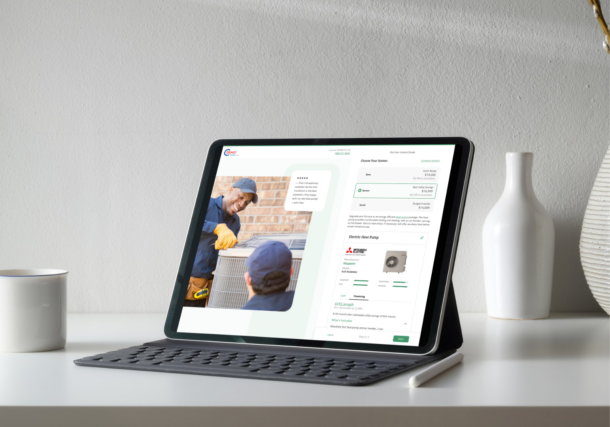
Building Trust Through Transparency
Marcus Sheridan’s exploration of consumer psychology in “They Ask You Answer” provides a stark reminder of the importance of transparency in pricing.
“The absence of price information doesn’t just inconvenience potential buyers; it actively drives them away,” Sheridan wrote in his book. “The modern consumer doesn’t just give up; they move on to someone who will meet their needs for information transparency.”
This perspective is especially relevant in the HVAC industry, where decisions are both infrequent and significant, making the stakes of transparency even higher.
Reflecting this, a recent survey from Clear Seas Research and The ACHR NEWS reveals a compelling trend: 71% of all homeowners express a preference for transparent online pricing and the figure jumps to 100% among Gen X and younger demographics. This data not only emphasizes the importance of clear pricing but also signals a shift towards greater consumer empowerment and expectation, challenging HVAC companies to adapt swiftly or risk losing out to more transparent competitors.
The Critical Role of Speed in Service
The concept of ‘speed to lead’ emphasizes the importance of quick responses to customer inquiries, which is vital in the HVAC industry. Equally crucial is the ‘speed to quote’, especially for younger generations who are accustomed to immediate gratification. The relationship between quick quote delivery and customer satisfaction is clear, particularly in industries like HVAC where timely decision-making is crucial. Speedy responses to quote requests reflect a company’s efficiency and responsiveness, qualities highly valued by today’s consumers.

Strategies for Fast, Accurate Quotes and Instant Gratification
Shifting homeowner demands and evolving demographics necessitate a strategic adaptation by HVAC contractors. This requires not only the implementation of best practices such as training customer service representatives and integrating digital tools like CRMs, texting platforms, but also new and innovative online sales tools. The ‘speed to quote’ race begins as soon as a potential customer lands on a contractor’s website, and using new online sales tools allows contractors to capture these potential customers and convert them into closed sales.
Adopting these new technologies not only meets the growing expectations for transparency, speed, and convenience but also ensures that contractors are aligned with the needs of Gen X, Millennial and Gen Z homeowners. By streamlining the quoting process and maintaining a focus on transparency, HVAC companies can significantly enhance their market appeal and meet the demands of a new generation that prioritizes quick, clear, and efficient service.
 Josh Koplin is a co-founder of EDEN, a Seattle-based startup with a mission to empower contractors with innovative technology, helping them to grow their businesses and provide exceptional customer experiences. Founded in 2021, EDEN provides a digital sales enablement tool to help HVAC contractors provide quick and accurate instant quotes for HVAC systems. By leveraging technology to provide prices and detailed breakdowns of eligible incentives and expected utility savings online, EDEN helps promote high-efficiency systems that contribute to sustainability and benefits both homeowners and contractors. For more information, visit https://www.e-denhomes.com/.
Josh Koplin is a co-founder of EDEN, a Seattle-based startup with a mission to empower contractors with innovative technology, helping them to grow their businesses and provide exceptional customer experiences. Founded in 2021, EDEN provides a digital sales enablement tool to help HVAC contractors provide quick and accurate instant quotes for HVAC systems. By leveraging technology to provide prices and detailed breakdowns of eligible incentives and expected utility savings online, EDEN helps promote high-efficiency systems that contribute to sustainability and benefits both homeowners and contractors. For more information, visit https://www.e-denhomes.com/.

By Tim Burge Recent insights from Bloomberg and the U.S. Bureau of Labor Statistics highlight a pressing issue within the U.S. economy: a notable shortage of skilled tradespeople, especially plumbers, leading to significant service delays and broader economic concerns. This shortfall is not confined to plumbing alone but spans across all trades, including installation, maintenance Read more
By Tim Burge
Recent insights from Bloomberg and the U.S. Bureau of Labor Statistics highlight a pressing issue within the U.S. economy: a notable shortage of skilled tradespeople, especially plumbers, leading to significant service delays and broader economic concerns. This shortfall is not confined to plumbing alone but spans across all trades, including installation, maintenance, and repair sectors. With an estimated 582,100 job openings emerging annually in these areas, the urgency to bridge this gap cannot be overstated.
Historically, trades careers have been deeply rooted in familial traditions, with expertise meticulously cultivated through years of apprenticeship and where knowledge is passed down from one generation to the next. However, as we surge forward in a digital age characterized by swift technological progress, the traditional charm of trades careers has waned, particularly among younger generations. The consequences of this shift are profound, touching not only on the crisis of labor availability but also on the operational efficiency and enduring viability of essential services. Simply put, without skilled technicians in trade jobs, critical aspects of infrastructure cannot be maintained.
However, the rise of emerging technologies is beginning to rectify the problems accumulated from a tradespeople shortage in the United States and beyond. These technologies allow for quicker access to information for these workers, as well as easing the managerial issues found by service managers.

AI as a Catalyst for Change
Artificial intelligence (AI) is emerging as a transformative tool in addressing the labor shortages within the trades. By simplifying troubleshooting and operational tasks, AI technology makes trade jobs more accessible and appealing to a technologically adept generation. This integration not only aims to fill the current gap but also to ensure the sustainability and appeal of trades careers for the future. The automation of complex diagnostic tasks into more manageable procedures reduces barriers for newcomers, enhancing the trade’s attractiveness and easing the pathway for new talent. In lieu of relying on the knowledge of veteran tradespeople — a group of workers retiring in droves from their trade careers —, AI can take the role of a mentor and copilot for those looking for answers on the job.
The Nature of Trade Jobs is Changing
As AI streamlines technical tasks, there’s a notable shift in the trade job landscape towards a more customer service-oriented focus. Customers are expecting more and more out of those they hire to complete their service jobs. This evolution means that soft skills such as communication, empathy, and problem-solving are becoming increasingly crucial. The role of tradespeople is expanding beyond the technical to encompass customer engagement and service, positioning them as both skilled technicians and valuable customer advisors.
This shift, supported by AI, presents an opportunity to redefine the trades, making them not only about technical proficiency but also about building strong customer relationships. By prioritizing soft skills alongside technical knowledge, tradespeople can better meet the evolving needs of their communities, ensuring the profession remains relevant and respected in an increasingly automated world.
Attracting the Next Generation
The average age of skilled tradesmen in the United States is 55, making the oncoming retiring age of many of those in the trades industries a critical issue. Today’s youth are digital natives, and their integration into the trades requires a shift in perception — viewing these careers as not only hands-on but also technologically advanced.
Demonstrating how AI and other digital tools can enhance job performance, efficiency, and satisfaction is essential. By leveraging technology, we can make these jobs more desirable, highlighting the innovative aspects of trade work that align with the interests and skills of younger generations.
Future-Proofing Through Technology
The adoption of AI in the trades also plays a pivotal role in ensuring the longevity and resilience of these services. With technology, we can optimize operations, reduce errors, and enhance service delivery, thus ensuring that the essential services provided by tradespeople remain robust against future challenges.
Moreover, the financial implications of not addressing this gap are significant. Research from AI and data company Aquant indicates that the cost of poor-performing talent can be up to 80% higher than that of top performers. This discrepancy underscores the importance of leveraging AI to not only attract but also retain and train high-performing talent, ensuring the economic viability of these trades.
What the Future Holds
As we navigate the challenges posed by labor shortages in the trades, AI stands out as a crucial ally. Its ability to simplify diagnostics, attract new talent, and ensure the sustainability of essential services highlights the importance of technological integration in the trades. While the implementation of AI and other digital tools represents a departure from traditional methods, it is a necessary evolution to address current challenges and future-proof these vital industries.
The dialogue on integrating AI into the trades is ongoing, and experts are continuously exploring innovative approaches to leverage technology in addressing the labor gap. By embracing AI, the trades can not only overcome current obstacles but also secure a robust, efficient, and sustainable future.
 About Tim Burge
About Tim Burge
Tim Burge, Director at Aquant, specializes in using advanced technologies to address real-world business challenges. With a strong background in the B2B software industry, his ability to merge technical know-how with business needs has made him a vital asset in driving innovation at Aquant, especially in the field service and contact center sectors.

CPVC is the only residential plumbing material that is immune to degradation or corrosion from exposure to chlorinated drinking water. CPVC is even unaffected by drinking water treated with aggressive methods that can increase the likelihood of premature failure in PEX and copper systems such as chlorine dioxide and chloramines. That means CPVC failures can Read more
CPVC is the only residential plumbing material that is immune to degradation or corrosion from exposure to chlorinated drinking water. CPVC is even unaffected by drinking water treated with aggressive methods that can increase the likelihood of premature failure in PEX and copper systems such as chlorine dioxide and chloramines. That means CPVC failures can almost always be traced to one of two causes: installation error or exposure to incompatible chemicals.
The Solvent Weld Process for Copper Tube Size CPVC
CPVC uses a solvent weld process to permanently weld fittings to pipes. When the process is performed properly, the pipe and fitting are fused into a single piece that creates a joint that is stronger than the pipe or fitting on their own. For plumbers who work with CPVC regularly, the solvent weld process gets to be second nature. But if you are new to CPVC, here are a few tips to keep in mind when using solvent cement. The tips provided are specific to Copper Tube Size CPVC (which is typically tan in color) and may not apply to IPS Schedule 80 CPVC (which is typically gray in color). Always consult your manufacturer for specific installation instructions.
- Use the right cement: Copper Tube Size CPVC can use one-step cement, such as FlowGuard® Gold 1-Step Yellow or new High Contrast Green Cement. The use of green solvent cement with CPVC was added to the 2024 codes of all major bodies to make it easier to visually inspect an installation.Because service plumbers often need to make repairs quickly and get to the next job, a specially formulated solvent cement, Oatey® Orange Lava, was developed. It enables one-step cure times as fast as 15 minutes for cold water lines. Always verify code requirements and follow the solvent cement manufacturer’s recommendations for cure times and installation procedures.
- Cut square and chamfer: Before applying solvent cement, the pipe should be cut square, and any tailings and bevel on the pipe end removed by chamfering.
- Avoid dry fits: A dry fit is simply putting a pipe and fitting together without applying solvent cement. This approach can increase the likelihood one or more fittings will not be solvent welded. Welding the system joint by joint is a better practice. You should check the fit of the pipe before assembling the joint. Without solvent cement, the pipe should fit tightly inside the fitting without bottoming out.
- Apply the right amount of cement: A good practice is to apply a heavy, even coat of one-step solvent cement to the outside of the pipe end. Then, using the same applicator without additional cement, apply a thin coat inside the fitting socket. Excess cement should not be allowed to puddle in the fitting assembly.
- Bottom out the pipe in the fitting: The more surface area of pipe that contacts the fitting, the stronger the bond. After the cement has been applied, the pipe should be inserted until it bottoms out against the fitting.
- Watch extreme temperatures: According to manufacturers of one-step CPVC solvent cement, the cement works best in temperatures between 40° F and 110° F. Outside that range, special precautions should be taken. Cements will cure more quickly in high temperatures and more slowly in cold temperatures. Check the can of solvent cement for proper working temperatures.
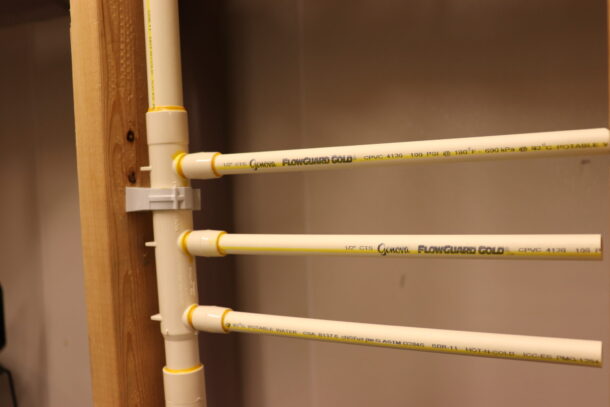
Expansion and Contraction
All piping materials will expand and contract based on differences between the installation and operating temperature of the system and changes in the temperature of the water flowing through the pipe. FlowGuard Gold CPVC can expand about 1 inch per 50 feet of straight length of pipe per 50°F temperature increase. If expansion and contraction aren’t accounted for in installation, the stress caused by this expansion can rise to 1200 psi. Because of CPVC’s incredible strength, this may not cause immediate failure in the system, but long-term exposure to these extreme stresses can cause failures after years in service.
In many cases, normal changes of direction can be enough to account for expansion and contraction provided the natural movement of the pipe is not restricted and there is adequate spacing between elbows and hangers. Overtightening pipe hangers may also restrict lateral movement of the pipe. For long, straight runs, loops or offsets can be used. If you have any questions, consult the manufacturer’s installation guidelines.
Chemical Incompatibility
If properly installed CPVC pipe experiences a failure, the likely culprit is contact with incompatible chemicals. Depending on the type and amount of incompatible chemical a pipe is exposed to, the failure may happen quickly or could take years to develop. For example, CPVC can be softened over time by the plasticizers contained in some rubbers and flexible vinyl products, so these materials should be prevented from contacting the pipe or fitting.
Service plumbers are most likely to encounter chemical incompatibility under sinks where the pipe can be exposed to surfactant chemicals found in some household cleaners. In these situations, a CPVC-to-copper stub-out should be used instead of stubbing out with a length of CPVC pipe.
The FBC™ System Compatible Program can be used to identify materials that are compatible and incompatible with FlowGuard Gold, BlazeMaster and Corzan CPVC. For other brands of CPVC piping, consult with the specific manufacturer(s) for compatibility information.
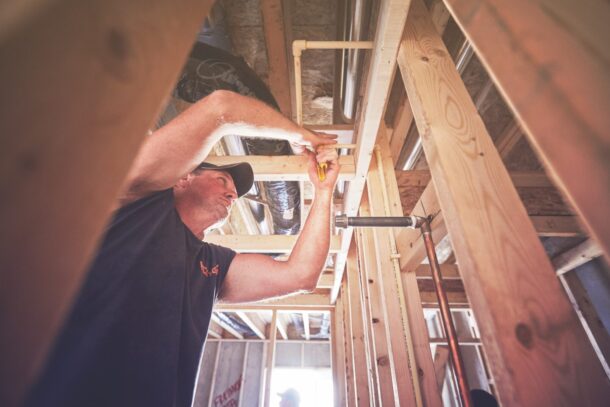
Handling Aged Pipe
As it ages, CPVC naturally becomes more rigid and may even show signs of discoloration. These changes do not reduce the expected service life of the pipe when properly installed. In fact, the pressure-bearing capability of CPVC pipes actually increases with age. But aged pipe should be handled and cut differently than new pipe. A C-style tubing cutter, fine-tooth saw or wheel cutter should be used when servicing CPVC. Ratchet cutters or shears are generally not recommended.
The Professional Plumber’s Choice
Professional plumbers appreciate CPVC because it is easy to work with and results in a clean, professional installation that highlights the plumber’s craftmanship and commitment to quality. For more information on CPVC, including step-by-step installation instructions and other resources, visit flowguardgold.com.
 Jonathan Simon is the North American residential plumbing manager for Lubrizol Advanced Materials Inc., the parent company for FlowGuard Gold Pipe and Fittings.
Jonathan Simon is the North American residential plumbing manager for Lubrizol Advanced Materials Inc., the parent company for FlowGuard Gold Pipe and Fittings.

Advanced electrode boilers are being installed to replace outdated, inefficient fuel-burning equipment in district heating applications as part of broader effort to meet ambitious International Energy Agency decarbonization goals. District heating—the generation of heat in a central location and distribution of it to local residences, businesses, and industry at greater economies of scale than individual Read more
Advanced electrode boilers are being installed to replace outdated, inefficient fuel-burning equipment in district heating applications as part of broader effort to meet ambitious International Energy Agency decarbonization goals.
District heating—the generation of heat in a central location and distribution of it to local residences, businesses, and industry at greater economies of scale than individual heating systems—plays an important role in helping the transition to clean energy in the fight against climate change. The challenge, however, is that district heating, used to provide hot water and heat within buildings through an insulated pipe system, must soon pivot from burning fossil fuels to cleaner forms of energy.
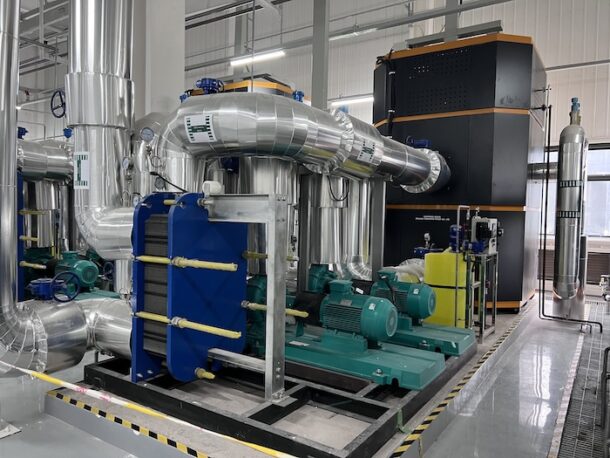
Electrode boilers can match the heating output of fuel burning boilers while converting almost all the energy to heat.
“District heating networks offer great potential for efficient, cost-effective, and flexible large-scale use of low-carbon energy for heating. However, the decarbonization potential of district heating is largely untapped, as 90% of the heat supplied in district networks is produced from fossil fuels …,” according to the International Energy Agency (IEA), a Paris-based autonomous intergovernmental organization that provides policy recommendations, analysis, and data on the global energy sector. The 31 member countries and 13 association countries of the IEA represent 75% of global energy demand.
Aligning with the IEA’s Net Zero Emissions by 2050 Scenario requires significant effort to rapidly improve the energy efficiency of existing networks, switch to renewable heat, integrate secondary heat sources, and develop new high-efficiency infrastructure.
Fortunately, innovation in the form of the latest, high voltage immersed electrode or jet type electrode boilers makes district heating much greener, particularly when the electricity comes from renewable sources like solar, wind, and hydro power.

The most advanced types of electrode boilers, such as Acme’s CEJS or CEJW, also offer greater safety than traditional fuel burning models.
Municipalities and businesses relying on district heating are already pivoting away from often inefficient, outdated equipment that produces excess carbon emissions in favor of economical electrode boilers that can quickly, flexibly rival the output of large gas or oil-fired boilers in a much smaller footprint, The advanced electrode boilers do not have a high minimum operating level to make them immediately available and offer much faster start-up and shut down time while being safely and easily maintained.
The Renewable Promise of District Heating with Electrode Boiler Technology
District heating systems offer substantial potential for improving energy efficiency, reducing greenhouse gas emissions, and integrating renewable and waste heat sources, particularly within urban centers.
In this effort, an increasing number of district heating plants are turning to high voltage, electrode boilers to absorb excess power production, quickly provide grid service, and cost-effectively balance out fluctuations. A growing number of municipalities are also installing new or retrofit high voltage electrode boilers that are compact, economical, and produce no emissions. The upgrades often entail retrofitting or replacing boilers (the heat source) with cleaner, more efficient electric alternatives, along with the heat distribution network (pipes/ heat exchanger stations).
Electrode boilers utilize the conductive and resistive properties of water to carry electric current and generate steam with great responsiveness and efficiency.
“An A.C. current flows from an electrode of one phase to ground using the water as a conductor. Since chemicals in the water provide conductivity, the current flow generates heat directly in the water itself. The more current (amps) that flows, the more heat (BTUs) is generated, and the more steam produced for use in district heating,” explains Robert Presser, Vice President of Acme Engineering, a manufacturer of industrial and commercial boilers with operations in the U.S., Canada, and Europe.
When supplying district heating, electrode boilers are much more responsive and flexible than fossil fuel burning units.
“With electrode boilers, the energy input and adjustment are very precise and virtually immediate. In contrast, increasing or decreasing the temperature in a gas fired boiler is a slower process because it takes time for the heat in the boiler to rise or dissipate before reaching the targeted output,” says Presser.
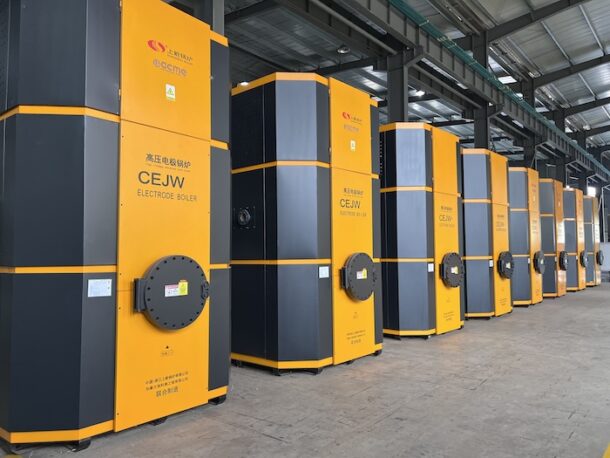
The energy efficiency of electrode boilers is one of their most remarkable characteristics; they are much more responsive and flexible than fossil fuel burning units.
Advanced high voltage electrode steam boilers like Acme’s CEJS also have a 100% turndown ratio, the ratio between a boiler’s maximum and minimum output. Most gas boilers have a ratio of 10:1 or 5:1, which means the units take a significant time to reach full capacity. The CEJW and CEJS immersed electrode hot water and steam boilers have a minimum output level of 7-8% of rated capacity, still far better than a modern gas-fired boiler.
“With a 100% turndown ratio, you can leave the boiler in standby at low pressure and bring it to full capacity in about 90 seconds as needed, which no other boiler type can achieve today,” says Presser.
“Communities and businesses utilizing district heating also appreciate the eco-friendly nature of electrode boilers. Without combustion, these boilers are clean and emission free. The design also eliminates many environmental issues associated with fuel burning boilers such as fuel fumes, fly ash, and large obtrusive exhaust stacks,” says Presser.
The energy efficiency of electrode boiler technology, however, is one of its most remarkable characteristics.
“For district heating, the extraordinarily efficient power-to-heat generation capability of electrode boilers, in which almost 100% of the electrical energy is converted into heat with no stack or heat transfer losses, combined with an ability to use and balance intermittent renewable energy, makes the technology crucial today,” says Presser.
As an example of energy and design efficiency, Acme’s CEJS electrode steam boiler produces maximum amounts of steam in minimal floor space, with boiler capacity from 6MW to 68MW. The electrode boiler operates at existing distribution voltages, 4.16 to 25 KV and is up to 99.9% efficient at converting energy into heat. The boiler can produce steam in capacities up to 270,000 pounds per hour, with pressure ratings from 75 PSIG to 500 PSIG. All CEJS boilers are designed to ASME Code or EU Pressure Vessels Directive and are certified, registered pressure vessels. Electrical standards meet CSA, UL, or CE requirements.
According to Presser, there are additional reasons for municipalities and businesses to use high voltage, jet type electrode boilers for district heating. “Electrode boilers can match the heating output of fuel burning boilers while converting almost all the energy to heat. Electrode boilers also are much smaller than fossil fuel burning boilers so are easier to use in smaller structures,” he says.
For residential or commercial property owners, electrode boilers also lower costs for installation, operation, and maintenance. Gas-fired boilers require fuel lines, storage and handling equipment, economizers, and emission control equipment. Advanced jet type electrode boilers have a minimal number of components and electrical controls, with fewer parts. Under normal operation, the absence of excessive temperatures and electrode burnout also assures long operating life.
In addition, the units further lower operating costs with automatic controls that reduce the need for operating personnel.
The most advanced types of these boilers, such as Acme’s CEJS or CEJW, also offer greater safety than traditional fuel burning models. “With the electrode boilers, there are no combustion hazards because there are no flames, fumes, fuel lines or storage tanks. There are no problems with heat buildup or electrode burnout even if scaling should occur, and thermal shock is eliminated. Also, there is no low water danger since the current cannot flow without water,” Presser explains.
Unlike fossil fuel burning boilers, electric boilers require minimal maintenance since there is no burner, no material burned, no soot created, no chimney, and no wearing mechanical parts, says Presser. With fewer parts than more complex fossil fuel burning units, electrical boilers are also more compact and simpler to install than conventional systems.
Finally, the electric units are exceptionally quiet compared to fuel fired boilers. Unlike gas-powered burners that throttle like turbine engines almost continually, electric boilers keep operational noise levels down.
With all the advantages of high output jet type electrode boilers, in addition to their value in balancing out the use of intermittent renewable energy in the power grid, it is evident why a growing number of communities and businesses are selecting them for district heating.
As the effects of climate change become more severe, the urgency of switching to clean energy and decarbonizing the energy sector will only increase across the globe. In this effort, district heating paired with electrode boilers will be a vital part of the solution, as member countries strive to meet the IEA decarbonization goals.
By Del Williams, a technical writer based in Torrance, California.

 About Tim Burge
About Tim Burge